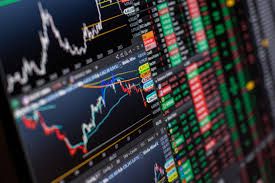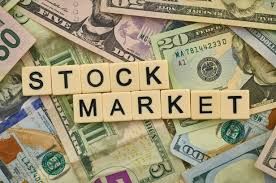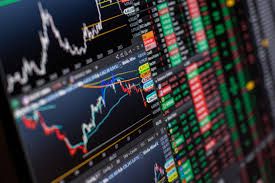𝗔 𝗚𝘂𝗶𝗱𝗲 𝗳𝗼𝗿 𝗔𝗺𝗲𝗿𝗶𝗰𝗮𝗻 𝗜𝗻𝘃𝗲𝘀𝘁𝗼𝗿𝘀
The stock market has been a cornerstone of wealth-building in the United States, offering individuals the chance to grow their savings and achieve financial independence. From Wall Street to Main Street, investing in stocks has helped millions of Americans build nest eggs for retirement, homeownership, or generational wealth.
While the market carries risks, strategic investing can yield substantial rewards over time. This guide explores the essentials of stock market investing, proven strategies, and practical steps to build wealth in the U.S. Whether you’re a beginner or looking to refine your approach, these insights will help you navigate the market with confidence

𝗨𝗻𝗱𝗲𝗿𝘀𝘁𝗮𝗻𝗱𝗶𝗻𝗴 𝘁𝗵𝗲 𝗨.𝗦. 𝗦𝘁𝗼𝗰𝗸 𝗠𝗮𝗿𝗸𝗲𝘁
𝙒𝙝𝙖𝙩 𝙞𝙨 𝙩𝙝𝙚 𝙎𝙩𝙤𝙘𝙠 𝙈𝙖𝙧𝙠𝙚𝙩?
The U.S. stock market is a network of exchanges where investors buy and sell shares of publicly traded companies. Major exchanges, like the New York Stock Exchange (NYSE) and Nasdaq, facilitate trading in companies ranging from tech giants like Apple to consumer staples like Procter & Gamble. By owning stocks, you gain a stake in a company’s growth and profits.
𝙒𝙝𝙮 𝙄𝙣𝙫𝙚𝙨𝙩 𝙞𝙣 𝙎𝙩𝙤𝙘𝙠𝙨?
Historically, U.S. stocks have delivered strong returns. The S&P 500, a benchmark of 500 large U.S. companies, has averaged an annual return of about 7-10% after inflation since the 1920s. This growth comes from capital appreciation (rising stock prices) and dividends (company payouts). Compared to low-yield savings accounts or bonds, stocks offer the potential for significant wealth accumulation through compounding.
𝙍𝙞𝙨𝙠𝙨 𝙖𝙣𝙙 𝙍𝙚𝙬𝙖𝙧𝙙𝙨
The stock market’s volatility—driven by economic shifts, corporate earnings, or global events—presents risks. For example, the 2008 financial crisis saw the S&P 500 drop nearly 40%. Yet, the market rebounded, rewarding patient investors. By understanding risks and employing smart strategies, you can mitigate losses and capitalize on opportunities.

𝗦𝗲𝘁𝘁𝗶𝗻𝗴 𝗙𝗶𝗻𝗮𝗻𝗰𝗶𝗮𝗹 𝗚𝗼𝗮𝗹𝘀 𝗳𝗼𝗿 𝗨.𝗦. 𝗜𝗻𝘃𝗲𝘀𝘁𝗼𝗿𝘀
𝘿𝙚𝙛𝙞𝙣𝙚 𝙔𝙤𝙪𝙧 𝙊𝙗𝙟𝙚𝙘𝙩𝙞𝙫𝙚𝙨
Your investment goals shape your strategy. Are you saving for a down payment on a home in California, funding a 529 plan for your child’s college, or building a retirement nest egg? Short-term goals (1-5 years) may require conservative investments, while long-term goals (10+ years) can tolerate higher-risk stocks. Align your investments with your timeline and priorities.
𝘼𝙨𝙨𝙚𝙨𝙨 𝙔𝙤𝙪𝙧 𝙍𝙞𝙨𝙠 𝙏𝙤𝙡𝙚𝙧𝙖𝙣𝙘𝙚
Risk tolerance depends on factors like age, income, and financial obligations. A 30-year-old tech worker in Seattle might embrace growth stocks, while a 60-year-old nearing retirement in Florida may prefer stable dividend payers. Use risk assessment tools from platforms like Vanguard or Fidelity to gauge your comfort with market swings.
𝘾𝙧𝙚𝙖𝙩𝙚 𝙖 𝙁𝙞𝙣𝙖𝙣𝙘𝙞𝙖𝙡 𝙋𝙡𝙖𝙣
A disciplined financial plan is key to wealth-building. After covering essentials—housing, groceries, and debt repayment—allocate funds to investing. The 50/30/20 rule (50% needs, 30% wants, 20% savings/investments) is a popular budgeting framework. For example, a $60,000 annual income could yield $1,000 monthly for investing, boosting your portfolio over time.

𝗚𝗲𝘁𝘁𝗶𝗻𝗴 𝗦𝘁𝗮𝗿𝘁𝗲𝗱 𝘄𝗶𝘁𝗵 𝗦𝘁𝗼𝗰𝗸 𝗠𝗮𝗿𝗸𝗲𝘁 𝗜𝗻𝘃𝗲𝘀𝘁𝗶𝗻𝗴
𝙀𝙙𝙪𝙘𝙖𝙩𝙚 𝙔𝙤𝙪𝙧𝙨𝙚𝙡𝙛
Knowledge is critical in the U.S. stock market. Learn about stock types (growth, value, dividend), key metrics like price-to-earnings (P/E) ratios, and market indices like the Dow Jones or Nasdaq. Resources like “A Random Walk Down Wall Street” by Burton Malkiel, Investopedia, or CNBC’s market coverage provide valuable insights. Following reputable investors on platforms like X can also offer real-time perspectives, but always verify information.
𝘾𝙝𝙤𝙤𝙨𝙚 𝙩𝙝𝙚 𝙍𝙞𝙜𝙝𝙩 𝙄𝙣𝙫𝙚𝙨𝙩𝙢𝙚𝙣𝙩 𝘼𝙘𝙘𝙤𝙪𝙣𝙩
U.S. investors have access to various accounts:
✓ Brokerage Accounts: Platforms like Charles Schwab, TD Ameritrade, or Robinhood offer flexibility to trade stocks, ETFs, and mutual funds.
✓ Retirement Accounts: Traditional or Roth IRAs and 401(k) plans provide tax advantages. For 2025, the IRA contribution limit is $7,000 ($8,000 if over 50), and 401(k) limits are $24,000 ($31,500 for those over 50).
✓ Robo-Advisors: Services like Betterment or Wealthfront automate investing based on your goals and risk tolerance, ideal for beginners.
𝙎𝙩𝙖𝙧𝙩 𝙎𝙢𝙖𝙡𝙡
You don’t need millions to invest. Many U.S. brokerages, like Fidelity or E*TRADE, offer fractional shares, letting you buy portions of stocks like Amazon or Tesla for as little as $10. Consistent small investments—say, $100 monthly in an S&P 500 ETF—can grow substantially through compounding.

𝗞𝗲𝘆 𝗦𝘁𝗿𝗮𝘁𝗲𝗴𝗶𝗲𝘀 𝗳𝗼𝗿 𝗕𝘂𝗶𝗹𝗱𝗶𝗻𝗴 𝗪𝗲𝗮𝗹𝘁𝗵
𝘿𝙞𝙫𝙚𝙧𝙨𝙞𝙛𝙞𝙘𝙖𝙩𝙞𝙤𝙣: 𝙋𝙧𝙤𝙩𝙚𝙘𝙩 𝙔𝙤𝙪𝙧 𝙋𝙤𝙧𝙩𝙛𝙤𝙡𝙞𝙤
Diversification reduces risk by spreading investments across sectors (e.g., technology, healthcare, energy) and asset classes (stocks, bonds, ETFs). For instance, a portfolio with Apple, Walmart, and a Vanguard S&P 500 ETF (VOO) balances growth and stability. ETFs and mutual funds are popular in the U.S. for instant diversification, with low-cost options like VOO or SPY tracking broad market indices.
𝙇𝙤𝙣𝙜-𝙏𝙚𝙧𝙢 𝙄𝙣𝙫𝙚𝙨𝙩𝙞𝙣𝙜 𝙖𝙣𝙙 𝘾𝙤𝙢𝙥𝙤𝙪𝙣𝙙𝙞𝙣𝙜
Patience is a hallmark of successful U.S. investors. A $10,000 investment in an S&P 500 ETF at an 8% annual return could grow to over $46,000 in 20 years, assuming no additional contributions. Avoid frequent trading, which incurs fees and taxes, and focus on holding quality investments for the long haul.
𝘿𝙤𝙡𝙡𝙖𝙧-𝘾𝙤𝙨𝙩 𝘼𝙫𝙚𝙧𝙖𝙜𝙞𝙣𝙜
This strategy involves investing a fixed amount regularly, regardless of market conditions. For example, contributing $500 monthly to a Nasdaq ETF (QQQ) lets you buy more shares when prices dip and fewer when prices rise, lowering your average cost. This approach mitigates the impact of market volatility, a common concern for U.S. investors.
𝘿𝙞𝙫𝙞𝙙𝙚𝙣𝙙 𝙄𝙣𝙫𝙚𝙨𝙩𝙞𝙣𝙜
Dividend stocks, like those from Coca-Cola or AT&T, provide passive income that can be reinvested. In 2025, “Dividend Aristocrats”—companies with 25+ years of consecutive dividend increases—are popular for stability. Reinvesting dividends through a Dividend Reinvestment Plan (DRIP) accelerates wealth-building via compounding.
𝙂𝙧𝙤𝙬𝙩𝙝 𝙫𝙨. 𝙑𝙖𝙡𝙪𝙚 𝙄𝙣𝙫𝙚𝙨𝙩𝙞𝙣𝙜
✓ Growth Investing: Targets companies with high growth potential, like Nvidia or Salesforce, which reinvest profits to fuel expansion. These stocks drive capital appreciation but may be volatile.
✓ Value Investing: Focuses on undervalued companies, like Berkshire Hathaway’s holdings, trading below their intrinsic value. Value stocks often offer dividends and stability.
A balanced U.S. portfolio might blend growth (e.g., tech) and value (e.g., financials) stocks.

𝗔𝘃𝗼𝗶𝗱𝗶𝗻𝗴 𝗖𝗼𝗺𝗺𝗼𝗻 𝗣𝗶𝘁𝗳𝗮𝗹𝗹𝘀
𝙀𝙢𝙤𝙩𝙞𝙤𝙣𝙖𝙡 𝙄𝙣𝙫𝙚𝙨𝙩𝙞𝙣𝙜
Market swings, like those during the 2020 COVID crash or 2022 inflation spikes, can spark fear or greed. Selling during downturns or chasing hot stocks (e.g., meme stocks like GameStop) often leads to losses. Stick to your plan and trust historical U.S. market resilience—since 1929, the S&P 500 has recovered from every crash.
𝙊𝙫𝙚𝙧𝙩𝙧𝙖𝙙𝙞𝙣𝙜
Frequent trading racks up commissions and short-term capital gains taxes (up to 37% in 2025 for high earners). A buy-and-hold strategy with low-cost ETFs minimizes costs and aligns with long-term wealth goals.
𝙄𝙜𝙣𝙤𝙧𝙞𝙣𝙜 𝙁𝙚𝙚𝙨
High fees erode returns. Actively managed funds often charge 1-2% annually, while index funds like Vanguard’s VTI have expense ratios as low as 0.03%. Compare brokerage fees and choose platforms with no or low trading commissions, a standard in the U.S. since 2019.
𝙇𝙖𝙘𝙠 𝙤𝙛 𝙍𝙚𝙨𝙚𝙖𝙧𝙘𝙝
Investing without due diligence is risky. Use tools like Morningstar, Yahoo Finance, or SEC filings (available on EDGAR) to analyze a company’s financials, leadership, and industry position. For example, check a firm’s debt-to-equity ratio or earnings growth before investing.

𝗔𝗱𝘃𝗮𝗻𝗰𝗲𝗱 𝗦𝘁𝗿𝗮𝘁𝗲𝗴𝗶𝗲𝘀 𝗳𝗼𝗿 𝗨.𝗦. 𝗜𝗻𝘃𝗲𝘀𝘁𝗼𝗿𝘀
𝙍𝙚𝙗𝙖𝙡𝙖𝙣𝙘𝙞𝙣𝙜 𝙔𝙤𝙪𝙧 𝙋𝙤𝙧𝙩𝙛𝙤𝙡𝙞𝙤
Rebalance annually to maintain your target allocation (e.g., 70% stocks, 30% bonds). If tech stocks surge, sell some to reinvest in underperforming sectors, ensuring alignment with your risk tolerance.
𝙏𝙖𝙭-𝙀𝙛𝙛𝙞𝙘𝙞𝙚𝙣𝙩 𝙄𝙣𝙫𝙚𝙨𝙩𝙞𝙣𝙜
Maximize after-tax returns:
✓ Use Roth IRAs for tax-free growth (ideal for young investors expecting higher future tax brackets).
✓ Hold investments over a year for lower long-term capital gains taxes (15-20% vs. 37% for short-term in 2025).
✓ Practice tax-loss harvesting, selling losing stocks to offset gains, a common U.S. strategy.
𝙇𝙚𝙫𝙚𝙧𝙖𝙜𝙚 𝙈𝙖𝙧𝙠𝙚𝙩 𝙏𝙧𝙚𝙣𝙙𝙨
Stay informed about U.S. economic trends, like AI growth or renewable energy. For instance, investments in companies like Tesla or NextEra Energy align with clean energy policies. Monitor Federal Reserve interest rate decisions, as they impact stock valuations, via sources like Bloomberg or X.
𝙍𝙚𝙞𝙣𝙫𝙚𝙨𝙩𝙞𝙣𝙜 𝙋𝙧𝙤𝙛𝙞𝙩𝙨
Reinvest dividends and gains to amplify returns. Many U.S. brokerages offer DRIPs, automatically purchasing additional shares. For example, reinvesting dividends from a stock like Johnson & Johnson can significantly boost long-term growth.

𝗧𝗼𝗼𝗹𝘀 𝗮𝗻𝗱 𝗥𝗲𝘀𝗼𝘂𝗿𝗰𝗲𝘀 𝗳𝗼𝗿 𝗨.𝗦. 𝗜𝗻𝘃𝗲𝘀𝘁𝗼𝗿𝘀
𝙄𝙣𝙫𝙚𝙨𝙩𝙢𝙚𝙣𝙩 𝙋𝙡𝙖𝙩𝙛𝙤𝙧𝙢𝙨
U.S. investors have access to user-friendly platforms like Robinhood, Fidelity, or Schwab, offering commission-free trading and educational tools. Robo-advisors like Betterment simplify investing for busy professionals.
𝙁𝙞𝙣𝙖𝙣𝙘𝙞𝙖𝙡 𝙉𝙚𝙬𝙨 𝙖𝙣𝙙 𝘼𝙣𝙖𝙡𝙮𝙨𝙞𝙨
Stay updated with U.S.-focused sources like The Wall Street Journal, CNBC, or posts on X from analysts like Jim Cramer or Cathie Wood. Cross-check X posts for accuracy to avoid hype-driven misinformation.
𝙋𝙤𝙧𝙩𝙛𝙤𝙡𝙞𝙤 𝙏𝙧𝙖𝙘𝙠𝙞𝙣𝙜
Apps like Personal Capital or Mint, popular in the U.S., track investments, monitor fees, and provide retirement planning tools. These help you visualize your portfolio’s performance and stay on track.
𝗕𝘂𝗶𝗹𝗱𝗶𝗻𝗴 𝗪𝗲𝗮𝗹𝘁𝗵 𝗕𝗲𝘆𝗼𝗻𝗱 𝗦𝘁𝗼𝗰𝗸𝘀
𝘿𝙞𝙫𝙚𝙧𝙨𝙞𝙛𝙮 𝙄𝙣𝙘𝙤𝙢𝙚 𝙎𝙩𝙧𝙚𝙖𝙢
Complement stocks with real estate (e.g., REITs), side hustles, or high-yield savings accounts. U.S. investors can explore platforms like Fundrise for real estate exposure without owning property.
𝙀𝙢𝙚𝙧𝙜𝙚𝙣𝙘𝙮 𝙁𝙪𝙣𝙙
Maintain 3-6 months of expenses in a high-yield savings account (e.g., Ally Bank, offering ~4% APY in 2025). This protects your stock portfolio from unexpected withdrawals.
𝘾𝙤𝙣𝙩𝙞𝙣𝙪𝙤𝙪𝙨 𝙇𝙚𝙖𝙧𝙣𝙞𝙣𝙜
The U.S. market evolves with tax laws, regulations, and trends. Attend webinars, read books like “The Millionaire Next Door,” or join investment clubs to stay sharp.
𝘾𝙤𝙣𝙘𝙡𝙪𝙨𝙞𝙤𝙣: 𝙔𝙤𝙪𝙧 𝙋𝙖𝙩𝙝 𝙩𝙤 𝙁𝙞𝙣𝙖𝙣𝙘𝙞𝙖𝙡 𝙎𝙪𝙘𝙘𝙚𝙨𝙨
Building wealth through the U.S. stock market requires discipline, knowledge, and a long-term perspective. By setting clear goals, diversifying, using strategies like dollar-cost averaging, and avoiding emotional pitfalls, you can harness the market’s potential. Start small, leverage tax-advantaged accounts like IRAs, and stay informed about U.S. economic trends. The stock market isn’t a quick fix, but with patience and strategy, it can pave the way to financial freedom.

